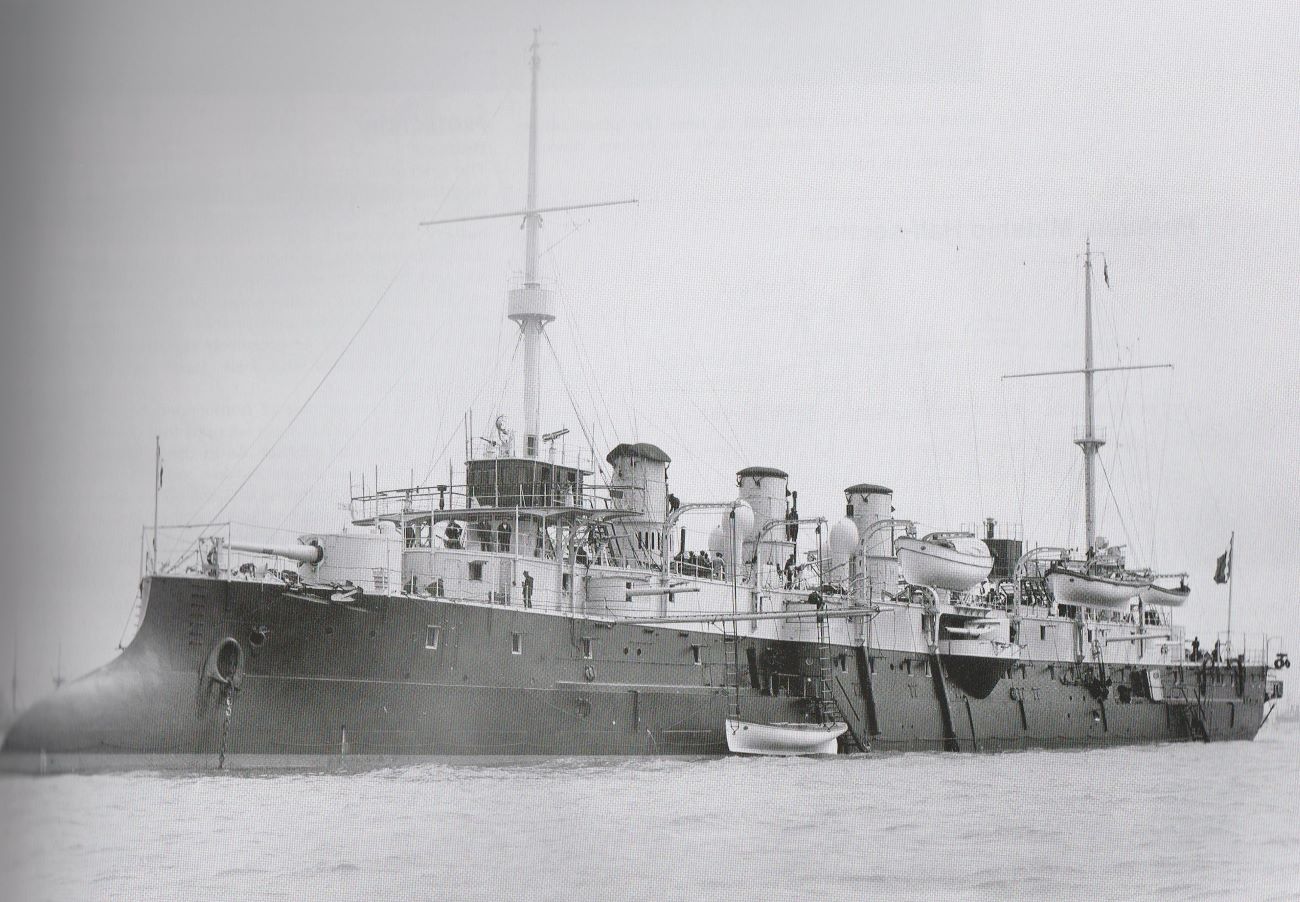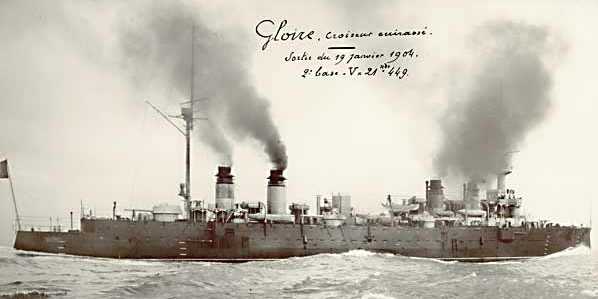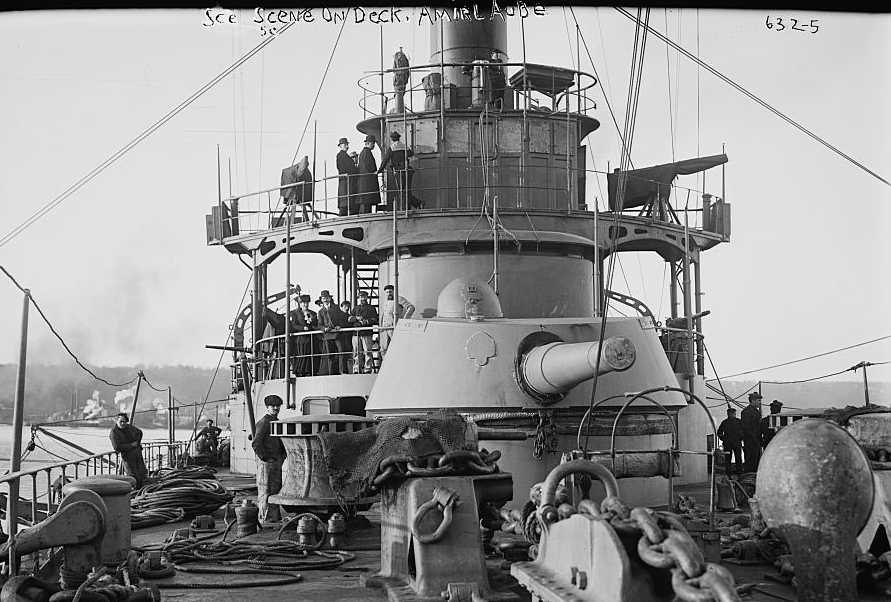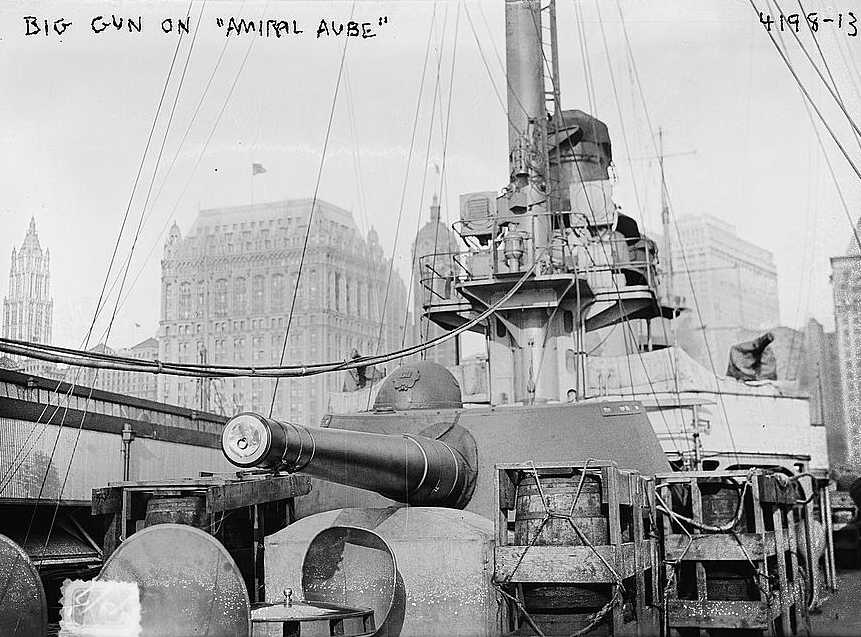
These were medium caliber guns first used on the cruiser flagship Pothuau. Some references state that this was the only ship armed with the Model 1893 guns, but recent research in "French Armoured Cruisers: 1887-1932" shows that it was also used on Jeanne d'Arc. These guns were shorter than the previous 19 cm/45 Model 1887 guns as it had been determined that the same performance could be had with a shorter gun without a reduction in the safety factor.
The Model 1893-1896 was a more powerful weapon with a chamber size 60 percent larger than that for the Model 1893 with a proportionally larger propellant charge, giving it a significantly higher muzzle velocity.
Both models were constructed of an A tube that was of uniform thickness except over the chamber, supported by a row of short hoops. The breech bush screwed on to the breech piece and abutted against the chamber hoop and the rear end of the A tube. Used an interrupted screw breech with four threaded and four plain sectors.
| Designation | 194 mm/40 (7.64") Model 1893
194 mm/40 (7.64") Model 1893-1896 |
|---|---|
| Ship Class Used On | Model 1893: Pothuau and Jeanne d'Arc
Model 1893-1896: Gueydon, Glorie and Leon Gambetta classes |
| Date Of Design | 1893 |
| Date In Service | Model 1893: 1897
Model 1893-1896: 1902 |
| Gun Weight | Model 1893: (10,840 kg)
Model 1893-1896: (12,682 kg) |
| Gun Length | Model 1893: (8.076 m)
Model 1893-1896: (8.120 m) |
| Bore Length | Model 1893: (7.760 m)
Model 1893-1896: (7.760 m)( |
| Rifling Length | N/A |
| Grooves | Model 1893: (58) 0.055 in deep x 0.118 in (1.4 mm x 3.0 mm)
Model 1893-1896: (58) 0.055 in deep x 0.118 in (1.4 mm x 3.0 mm) |
| Lands | N/A |
| Twist | Model 1893: Inclined at 5 degrees
Model 1893-1896: Inclined at 4 degrees |
| Chamber Volume | Model 1893: 2,991in3 (49.030 dm3)
Model 1893-1896: 4,383 in3 (71.845 dm3) |
| Rate Of Fire | about 2 rounds per minute |
| Type | Bag |
|---|---|
| Projectile Types and Weights | CI 1 - 165.3 lbs. (75 kg)
APC - 199.1 lbs. (90.3 kg) SAPC 2 - 197.3 lbs. (89.5 kg) |
| Bursting Charge | CI - 11.2 lbs. (5.07 kg) black powder
APC - 3.5 lbs. (1.590 kg) Mélinite SAPC - 9.5 lbs. (4.330 kg) Mélinite |
| Projectile Length | CI - 22.8 in (58.0 cm)
APC - 20.6 in (52.4 cm) SAPC - 23.2 in (59.0 cm) |
| Propellant Charge | Model 1893: 49.2 lbs. (22.3 kg) BM9 3 Model 1893-1896: 74.5 lbs. (33.8 kg) BM10 or BM11 4 |
| Muzzle Velocity for Model 1893 | CI - 2,625 fps (800 mps)
APC - 2,525 fps (770 mps) SAPC - 2,525 fps (770 mps) |
| Muzzle Velocity for Model 1893-1896 | CI - 2,625 fps (875 mps)
APC - 2,525 fps (840 mps) SAPC - 2,525 fps (840 mps) |
| Working Pressure for Model 1893 | CI - 13.67 tons/in2 (2,150 kg/cm2)
APC - 14.62 tons/in2 (2,300 kg/cm2) SAPC - 14.18 tons/in2 (2,230 kg/cm2) |
| Working Pressure for Model 1893-1896 | CI - 16.53 tons/in2 (2,600 kg/cm2)
APC - 17.80 tons/in2 (2,800 kg/cm2) SAPC - 17.80 tons/in2 (2,800 kg/cm2) |
| Approximate Barrel Life | N/A |
| Ammunition stowage per gun | Model 1893: N/A
Model 1893-1896: about 70 rounds per gun |
| Elevation | Distance |
|---|---|
| 14.2 degrees | 12,580 yards (11,500 m) |
| Elevation | Distance |
|---|---|
| 15 degrees | 12,580 yards (11,500 m) |
As in most ships of this era, long range gunfire was nearly impossible and for that reason the maximum range figures seen in secondary and even primary sources should be viewed with a degree of skepticism. Instead, designers were more concerned about performance at a range where most combats would take place. For these ships, the French considered that 2,000 m (2,100 yards) would be the most likely combat range.
| Shell Type | Remaining Velocity | Drift | Mean error in range | Mean error in line |
|---|---|---|---|---|
| CI | 1,970 fps (600 mps) | 29 in (0.74 m) | 70.0 feet (21.3 m) | 43 in (1.1 m) |
| APC | 2,030 fps (619 mps) | 33.8 in (0.86 m) | 134.5 feet (41.0 m) | 37 in (0.93 m) |
| Shell Type | Remaining Velocity | Drift | Mean error in range | Mean error in line |
|---|---|---|---|---|
| CI | 2,142 fps (653 mps) | 33.5 in (0.85 m) | 154.9 feet (47.2 m) | 210 in (0.99 m) |
| APC | 2,228 fps (679 mps) | 47.2 in (1.2 m) | 160.4 feet (48.9 m) | 37.8 in (0.96 m) |
| Designation | Single Turrets
Model 1893 1a: Pothuau (2) and Jeanne d'Arc (2) Model 1893-1896 2a: Gueydon and Glorie Twin Turrets
|
|---|---|
| Weight | N/A |
| Elevation | Dupuy de Lôme: -5 / +15
Amiral Charner: -6 / +14.2 Others: -5 / +15 |
| Elevation Rate | N/A - Manually operated |
| Train | about -150 / +150 degrees |
| Train Rate | N/A |
| Gun recoil | N/A |
| Loading Angle | -5 degrees |
- ^The Model 1893 turrets were similar in design and shape to the Model 1887 of Latouche-Trèville. Like that earlier design, these pivot-shaft turrets were a balanced design with an elliptical gunhouse with training provided by electric motors. Elevation was by hand. Handling rooms were at the base of the pivot with adjacent powder and shell rooms. A single electrically powered hoist came up to the right of the gun where it was transferred to the breech via a hinged arm. Projectile and powder bags were manually rammed separately.
- ^The later Model 1893-1896 mountings were generally similar to the Model 1893 with the major difference being a working chamber located beneath the gunhouse. This had a circular projectile ring holding eight ready projectiles and housed twenty-four ready propellant charges in flash-proof lockers around the walls. The propellant hoist carried two complete rounds at a time. The hoist on Gueydon was offset to the left of the turret, but the ones on succeeding ships had the hoist on the turret axis. Projectiles were moved from the shell rooms in a steel crate via an overhead rail. Projectile and three charges were placed into individual cells in a circular basket. The duplex hoist had two linked baskets; while one was raised the other was lowered. The hoist was operated by an electric motor with a manual backup. Projectiles were moved from the basket by a small hand winch and moved to the circular projectile ring. The bagged charges were removed by hand and placed into the vertical lockers. The projectile ring could be rotated by hand to move any desired shell under the hand-worked clip hoist. This raised the shell to the left side of the gun where it was then lifted or shunted onto one of three waiting trays or else moved directly to the gun breech. To the left of the breech were three hand-worked propellant scuttles. Three ready-use charges were stowed horizontally beneath the waiting trays and there was vertical stowage for six more charges on the left hand wall of the turret. This gave a total of three complete ready-use rounds in the gunhouse and a further eight in the working chamber. In place of the rotating tray on earlier guns, there was a fixed tray set at -5 degrees that traversed laterally on a system of bars from a position just behind the waiting trays and was aligned with the breech when the gun was lowered to the -5 degree loading angle. Ramming of both shell and powder bags was done by hand
- ^The twin turret was generally similar to the single Model 1893-1896 turret including having a single duplex hoist that served both guns. Guns were individually sleeved and manually elevated.



"Naval Weapons of World War Two" by John Campbell
"French Warships of World War I" by Jean Labayle Couhat - Ian Allan Series
"Naval Weapons of World War One" by Norman Friedman
"French Armoured Cruisers: 1887 - 1932" by John Jordan and Philippe Caresse
---
Tony DiGiulian's personal files
---
Ministère de la défense
---
Special Help by Michal Derela and John Jordan
28 December 2008 - Benchmark
29 November 2019 - New Datapage split off from 194 mm/50 Model 1902 datapage
